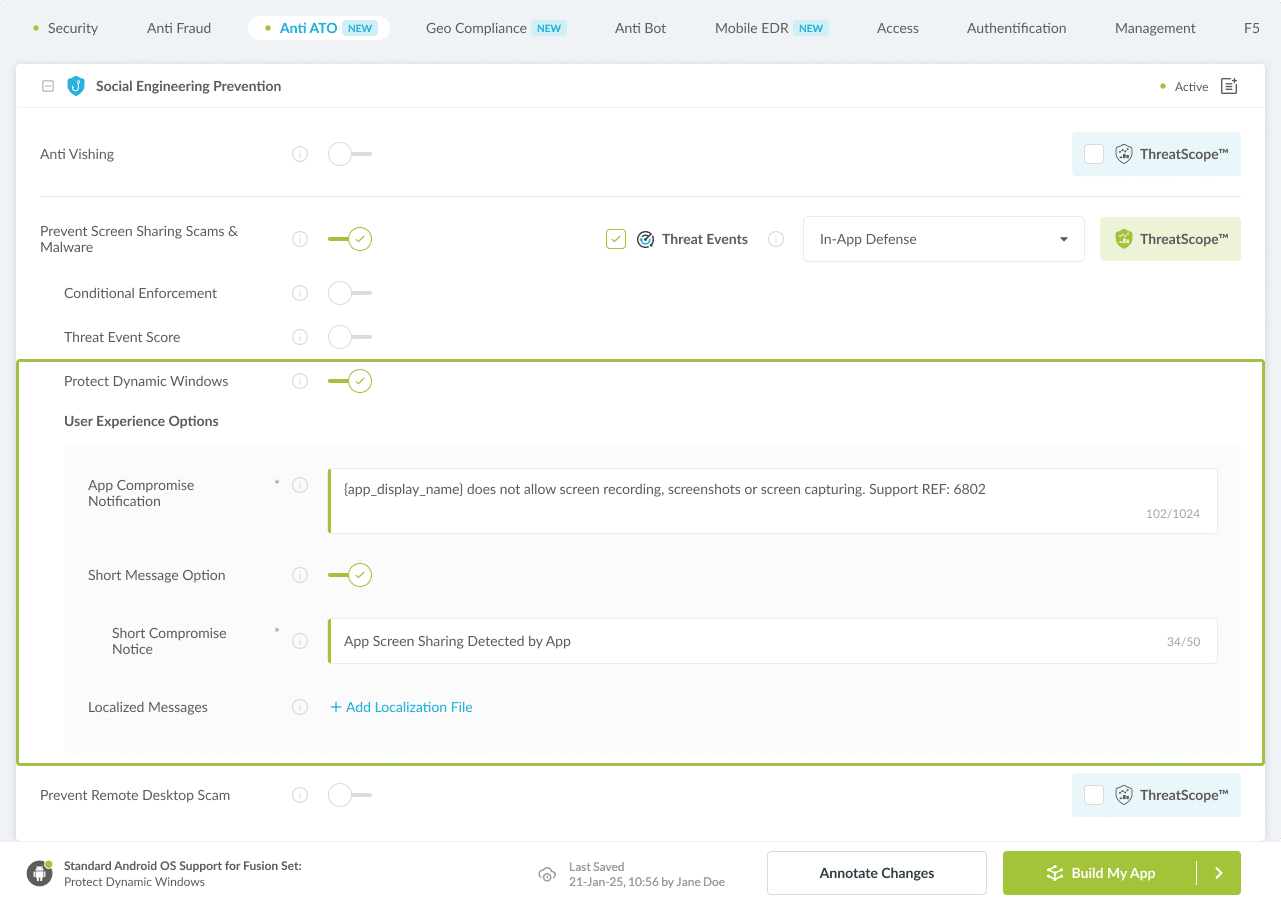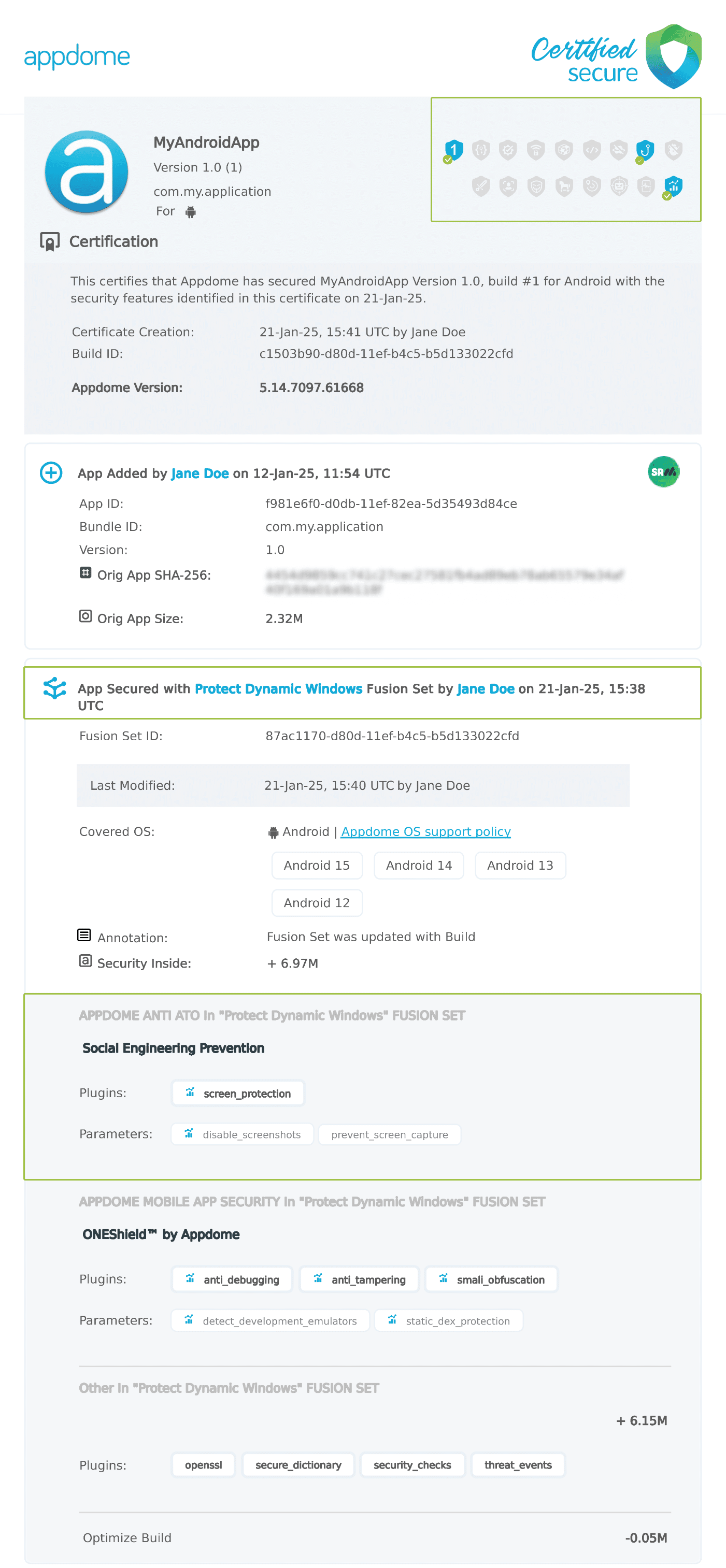How to Protect Dynamic Windows and Dynamic Content in Android Apps
This Knowledge Base article describes how to use Appdome’s AI/ML in your CI/CD pipeline to continuously deliver plugins that Prevent the visibility of dynamic windows on screen grab applications in Android apps.
What are Dynamic Windows and Dynamic Content in Android Apps?
Protecting dynamic windows and floating UI elements in Android apps is critical for safeguarding sensitive data against unauthorized screen grabs, mirroring, or recordings. Attackers often exploit gaps in Android’s FLAG_SECURE mechanism, which fails to secure certain child UI components or dynamically generated windows like popups, toasts, dialog fragments, and spinners. These vulnerabilities expose high-risk apps in sectors such as banking, healthcare, and business to potential data theft. Extending protection to these elements ensures sensitive information remains secure, especially in high-security or regulated environments, where compliance with stringent data protection standards is essential.
How Appdome Protects Dynamic Windows and Dynamic Content in Android Apps?
Appdome’s dynamic Prevent App Screen Sharing plugin ensures that sensitive data from Android app screens, including floating windows and dynamically generated content, is protected against unauthorized screen-sharing, mirroring, and screenshots. Appdome goes beyond Android’s FLAG_SECURE mechanism by implementing Protect Dynamically Generated Windows, which extends protection to UI elements that don’t expose a developer-facing API, such as spinners, toasts, dialog fragments, and popups. This feature ensures that all such elements remain hidden from screen grab tools and cannot be captured by unauthorized methods.
Additionally, Appdome addresses Android’s FLAG_SECURE design flaw, which prevents some child UI elements of activities or fragments from being secured. Appdome’s solution automatically secures these elements without requiring code modifications from developers, offering full protection for UI components like DialogFragment, AlertDialog, PopupMenu, Toast, Spinner, and others. Even in third-party frameworks like React-Native, where FLAG_SECURE cannot be applied natively, Appdome ensures complete security coverage. This solution allows developers to safeguard sensitive app data displayed in dynamic windows without any extra development effort.
Prerequisites for Using Appdome's Protect Dynamic Windows Plugins:
To use Appdome’s mobile app security build system to Prevent the visibility of dynamic windows on screen grab applications , you’ll need:
- Appdome account (create a free Appdome account here)
- A license for Protect Dynamic Windows
- Mobile App (.apk or .aab for Android)
- Signing Credentials (see Signing Secure Android apps and Signing Secure iOS apps)
How to Implement Prevent the visibility of dynamic windows on screen grab applications in Android Apps Using Appdome
On Appdome, follow these 3 simple steps to create self-defending Android Apps that Prevent the visibility of dynamic windows on screen grab applications without an SDK or gateway:
-
Designate the Mobile App to be protected.
-
Upload an app via the Appdome Mobile Defense platform GUI or via Appdome’s DEV-API or CI/CD Plugins.
-
Android Formats: .apk or .aab
-
Protect Dynamic Windows is compatible with: Java, JS, C++, C#, Kotlin, Flutter, React Native, Unity, Xamarin, Cordova and other Android apps.
-
-
Select the defense: Protect Dynamic Windows.
-
-
Follow the steps in Sections 2.2-2.2.2 of this article to add the Protect Dynamic Windows feature to your Fusion Set via the Appdome Console.
-
When you select the Protect Dynamic Windows you'll notice that the Fusion Set you created in step 2.1 now bears the icon of the protection category that contains Protect Dynamic Windows.

Figure 2: Fusion Set that displays the newly added Protect Dynamic Windows protection
Note: Annotating the Fusion Set to identify the protection(s) selected is optional only (not mandatory). -
Open the Fusion Set Detail Summary by clicking the “...” symbol on the far-right corner of the Fusion Set. Copy the Fusion Set ID from the Fusion Set Detail Summary (as shown below):

Figure 3: Fusion Set Detail Summary
-
Follow the instructions below to use the Fusion Set ID inside any standard mobile DevOps or CI/CD toolkit like Bitrise, Jenkins, Travis, Team City, Circle CI or other system:
-
Refer to the Appdome API Reference Guide for API building instructions.
-
Look for sample APIs in Appdome’s GitHub Repository.
-
Create and name the Fusion Set (security template) that will contain the Protect Dynamic Windows feature as shown below:
Figure 1: Fusion Set that will contain the Protect Dynamic Windows feature
-
-
Add the Protect Dynamic Windows feature to your security template.
-
Navigate to Build > Anti ATO tab > Social Engineering Prevention section in the Appdome Console.
-
Toggle On Protect Dynamic Windows.

Figure 4: Selecting Prevent the visibility of dynamic windows on screen grab applications
- Optional Configuration with Protect Dynamic Windows:
- Protect Dynamically Generated Windows
Extends App Screen Sharing Prevention to all Android floating windows.
-
Congratulations! The Protect Dynamic Windows protection is now added to the mobile app -
-
Certify the Protect Dynamic Windows feature in Android Apps
After building Protect Dynamic Windows, Appdome generates a Certified Secure™ certificate to guarantee that the Protect Dynamic Windows protection has been added and is protecting the app. To verify that the Protect Dynamic Windows protection has been added to the mobile app, locate the protection in the Certified Secure™ certificate as shown below:

Figure 5: Certified Secure™ certificate
Each Certified Secure™ certificate provides DevOps and DevSecOps organizations the entire workflow summary, audit trail of each build, and proof of protection that Protect Dynamic Windows has been added to each Android app. Certified Secure provides instant and in-line DevSecOps compliance certification that Protect Dynamic Windows and other mobile app security features are in each build of the mobile app.
Using Appdome, there are no development or coding prerequisites to build secured Android Apps by using Protect Dynamic Windows. There is no SDK and no library to code or implement in the app and no gateway to deploy in your network. All protections are built into each app and the resulting app is self-defending and self-protecting.
Releasing and Publishing Mobile Apps with Protect Dynamic Windows
After successfully securing your app by using Appdome, there are several available options to complete your project, depending on your app lifecycle or workflow. These include:
- Customizing, Configuring & Branding Secure Mobile Apps.
- Deploying/Publishing Secure mobile apps to Public or Private app stores.
- Releasing Secured Android & iOS Apps built on Appdome.
Related Articles:
- How to Protect Android & iOS Apps from Copy/Paste Attacks
- How to Use Trusted App Groups with Copy Paste Prevention
- How to Block Team Viewer and Remote Desktop Exploits in Android Apps
How Do I Learn More?
If you have any questions, please send them our way at support.appdome.com or via the chat window on the Appdome platform.
Thank you!
Thanks for visiting Appdome! Our mission is to secure every app on the planet by making mobile app security easy. We hope we’re living up to the mission with your project.
